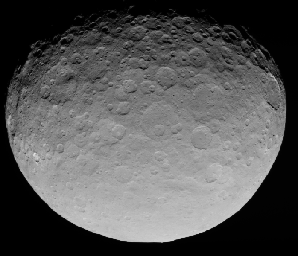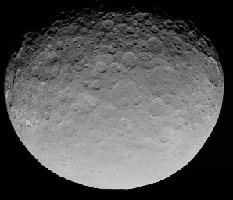
|
Ceres RC3 Animation
- Click the image above for a larger view
 Movie Download Options
Movie Download Options- Full-Res JPEG (774 x 665) (53.2 kB)
- Full-Res TIFF (774 x 665) (515.5 kB)
Caption:

Click on the image for the animation
This animation shows a sequence of images taken by NASA's Dawn spacecraft on May 4, 2015, from a distance of 8,400 miles (13,600 kilometers), in its RC3 mapping orbit. The image resolution is 0.8 mile (1.3 kilometers) per pixel.
In this closest-yet view, the brightest spots within a crater in the northern hemisphere are revealed to be composed of many smaller spots. However, their exact nature remains unknown.
Background Info:
Dawn's mission is managed by JPL for NASA's Science Mission Directorate in Washington. Dawn is a project of the directorate's Discovery Program, managed by NASA's Marshall Space Flight Center in Huntsville, Alabama. UCLA is responsible for overall Dawn mission science. Orbital ATK, Inc., in Dulles, Virginia, designed and built the spacecraft. The German Aerospace Center, the Max Planck Institute for Solar System Research, the Italian Space Agency and the Italian National Astrophysical Institute are international partners on the mission team. For a complete list of acknowledgements, visit http://dawn.jpl.nasa.gov/mission .
For more information about the Dawn mission, visit http://dawn.jpl.nasa.gov .
Cataloging Keywords:
| Name | Value | Additional Values |
|---|---|---|
| Target | 1 Ceres | |
| System | Main Belt | |
| Target Type | Dwarf Planet | Asteroid |
| Mission | Dawn | |
| Instrument Host | Dawn | |
| Host Type | Orbiter | |
| Instrument | Framing Camera (FC) | |
| Detector | ||
| Extra Keywords | Crater, Grayscale, Movie | |
| Acquisition Date | ||
| Release Date | 2015-05-11 | |
| Date in Caption | 2015-05-04 | |
| Image Credit | NASA/JPL-Caltech/UCLA/MPS/DLR/IDA | |
| Source | photojournal.jpl.nasa.gov/catalog/PIA19547 | |
| Identifier | PIA19547 | |
